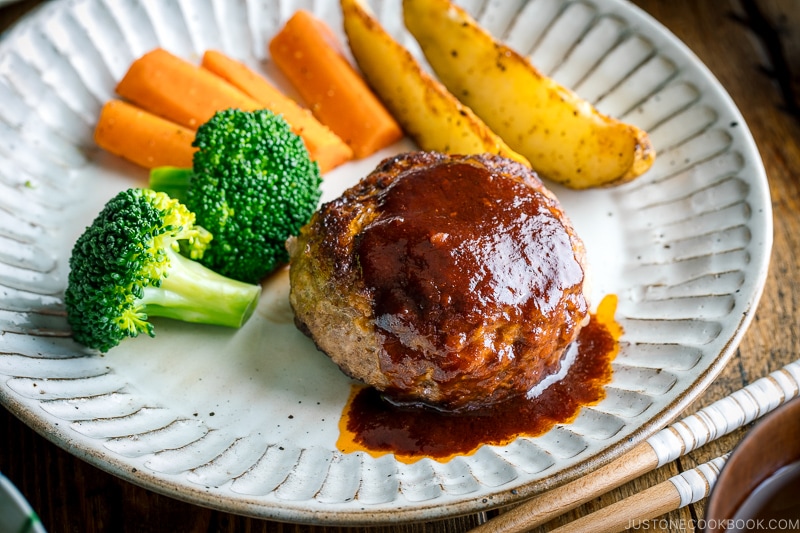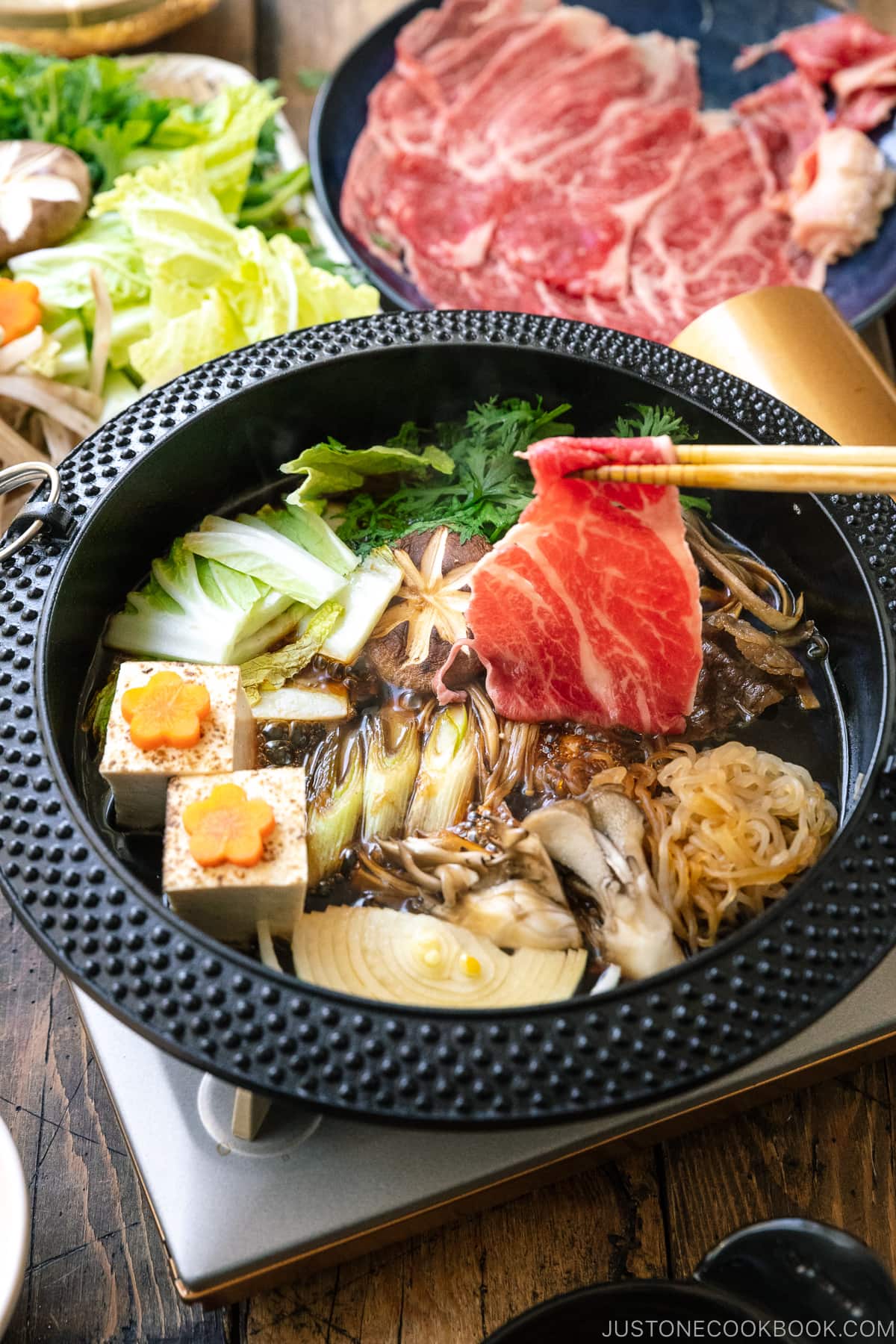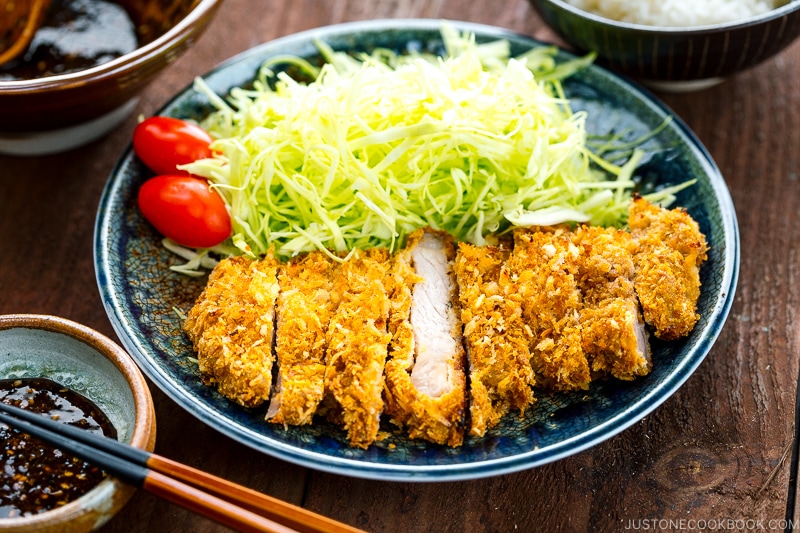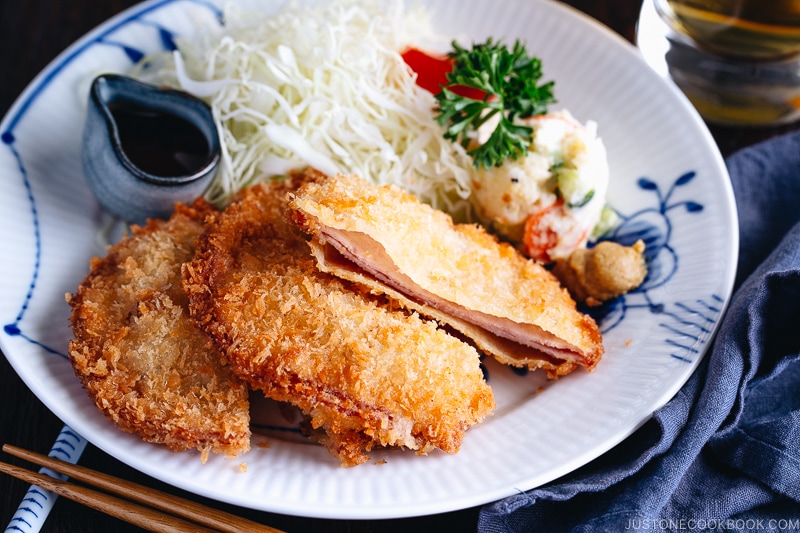What is Yoshoku? What is the history behind this Western-influenced Japanese cuisine? Let us discover the world of this East meets West cuisine today and make some delicious recipes.

Why are French, Italian, and other Western dishes such as curry and deep-fried foods now integral to Japanese cuisine? Then, we must dive into the story of Yoshoku (洋食) – a Japanese adaptation of Western cuisine that traces its history to the late 19th century and continues to evolve to this day, beloved by Japanese, both old and young alike.
A little digging into Japanese history will show how Yoshoku is distinctly Japanese and not simply a fusion of French or Italian cuisine. It is heavily influenced by the wave of events and powers that shaped the country into what it is today.
Table of Contents

History of Yoshoku
Meiji Era (1868-1912)
To begin talking about the origins of Yoshoku, let’s go back to the Meiji era (明治時代).
The arrival of Commodore Matthew Perry at Kurihama in 1853 triggered the rapid modernization of Japan from an isolated feudal society. As portrayed in the historical fiction movie The Last Samurai or the popular anime and manga Rurouni Kenshin, this era marked a dramatic turning point in Japanese history where, to avoid the fate of many colonized Asian countries by Western powers, Japan opened its borders and aggressively integrated Western elements. This change affected not only its sociopolitical structure, economy, military, and foreign relations but also its food culture and customs, namely the practice of eating four-legged animals.
Prohibition of Meat Consumption
You may have noticed that the traditional Japanese diet is mainly fish and seafood-based. This is because the “open” consumption of meat is relatively new.
Several factors, such as the introduction of Buddhism from China, the rise of Shintoism and its teachings on the impurity of slaughtering, and Emperor Tenmu’s decree of banning the killing and eating of meat during certain times of the year (675 AD) created an ambiguous and undefined social taboo against the practice.
However, the consumption of wild game remained prevalent throughout the centuries, as an open secret for those seeking its nutritional and caloric benefits but not spoken of.

This taboo was lifted with the announcement of the Meiji emperor incorporating beef and mutton into his daily diet in 1872, encouraging its people to do the same. Beef and pork quickly popularized, and various food establishments flourished nationwide, devising creative and delicious ways to satisfy hungry customers.

Five Popular Yoshoku Dishes and Background
Now that you’ve gotten a brief history of the Meiji era and the history behind Yoshoku, let’s look into the iconic dishes that are still popular today!
Curry Rice

Curry was first brought to Japan by officers of the British Royal Navy at the end of the 19th century. The dish caught the eye of the Imperial Japanese Navy, which was facing a massive beriberi epidemic among its soldiers due to a severe vitamin B deficiency. Incorporating wheat, a vitamin B food product, in the form of wheat into curry eradicated the disease in the Japanese navy within a few years. This new curry fulfilled a nutritional need, and its popularity spread beyond the navy.
Since then, it has become a tradition at the Japanese Maritime Self-Defense Force to serve Japanese curry every Friday, and each JMSDF ship has its own secretly guarded recipe.
Adding potatoes, carrots, and onions to Japanese curry came later, introduced by the American professor William Clark of the Sapporo Agricultural College (now the University of Hokkaido) in 1876. Not only were root vegetables grown in abundance on campus grounds, but it was also a trick to bulk up the dish for the hungry college students during a rice shortage.
More Japanese Curry Recipes:
Doria

Doria is a baked casserole featuring rice topped with white sauce, cheese, and various ingredients.
This dish was invented in the 1930s by Saly Weil, the first head chef at the Hotel New Grand in Yokohama. The story goes that a Swiss banker staying at the hotel got sick and requested something easy to digest. The chef combined pilaf (rice cooked in broth and vegetables) and shrimp cooked in cream sauce, then baked in the oven until golden brown.
More Doria Recipes:
Napolitan (Ketchup Pasta)

A uniquely Japanese dish, there’s nothing Neopolitan or Italian about this ketchup-seasoned udon-soft spaghetti stir-fried with vegetables and meat.
Napolitan was born during the postwar era at the New Grand Hotel in Yokohama, where the U.S. military under Douglas MacArthur set up base. With minimal produce, Shigetada Irie, the head chef of the New Grand Hotel, drew inspiration from the American military personnel eating spaghetti and ketchup (ingredients no doubt chosen for its easy cooking, shipping, and storage). To serve the dish at the hotel, Irie swapped the ketchup (a difficult ingredient to procure during the postwar period) for tomato puree and added sautéed onions, ham, and mushrooms. As the dish became known outside of the hotel and caught the eyes of the Japanese, tomato puree was replaced with ketchup.
You’ll notice (to any Italian nonna’s horror) that the spaghetti is boiled way past al dente to udon consistency. This is a crucial characteristic of Napolitan; the noodles are boiled tender like Japanese noodles for that soft texture. The noodles are then stir-fried, emulating stir-fried Yaki Udon (焼うどん). Thus, the dish was oddly familiar and appealing despite featuring ingredients foreign to the traditional Japanese diet.
Tonkatsu

Tonkatsu is composed of “Ton” = pork and “Katsu” = cotelette (the French word for a thinly cut slice of veal, pork, or mutton that’s breaded and deep fried). The iconic dish goes back to 1899, at Rengatei (煉瓦亭) in Ginza, where they served customers “Pork Cutlet” (豚肉のカツレツ), which was pork slices sautéed in butter, then baked in the oven. A side of steamed vegetables always accompanied the dish.
The technique of deep frying came later when a severe labor shortage during the Russo-Japanese War (1904-1905) resulted in the Rengatei head chef coating the meat in a batter similar to tempura, then deep frying. The steamed vegetables were later replaced with shredded cabbage, favored for its quick preparation and availability year-round.
More Tonkatsu Recipes:
Omurice

The term Omurice is a fusion of “omelet” and “rice,” and its origins are murky and contested. There are two leading theories that it either came from Rengatei (煉瓦亭) in Ginza or from Hokkyokusei 北極星 in Osaka, both famous Yoshoku restaurants that still exist today.
The Rengatei version was beaten eggs with rice and ground meat cooked in an omelet shape. It was a quick meal for Rengatei employees who could scarf it down with a spoon, but curious customers began ordering it as well, so the dish was put on the menu in 1901 as “Rice Omelette” (ライスオムレツ). The ketchup accompaniment was a later addition, as the condiment became popular around 1908.
Hokkyokusei’s version was ketchup-flavored rice with mushrooms and minced onions wrapped in a thin egg crepe, resembling the Omurice we know today. It is said that the dish was created around 1925 by a request from a loyal customer for something easily digestible.
Yoshoku Today

Both casual and upscale, Yoshoku was à la mode compared to the rice and fish-based Washoku meal during the postwar period.
Yoshoku can still be found today, served at Famiresu (ファミレス, casual diner chains), cafes (カフェ), Kissaten (喫茶店, old-school Japanese coffee houses), hotel restaurants, and even at convenience stores. Many restaurant establishments still proudly serve their signature dishes that artists, celebrities, and politicians have loved for decades, such as Rengatei and Hokkyokusei.
It is also home food, where mothers may opt for Yoshoku dishes such as omurice or curry, a less labor-intensive one-plate meal than the typical Washoku spread. For the children, deep-fried foods such as tonkatsu and korokke are a rare treat. For grown adults, it is reminiscent of these childhood memories of weekend meals at home, like the characters on the TV (Netflix) drama Midnight Diner ordering Ham Katsu or White Stew.

Neither entirely European nor Washoku, the Japanese adaptation of Western food from the late 1800s is an integral part of Japanese cuisine. While the definition is broad, it has firm roots in Western cuisine but has been modified to suit the Japanese palate.
I hope this article helped answer your questions regarding Yoshoku and its place in modern Japanese history and cuisine!











Kayoko, I have been following your website and emails for about 6 months now. I have always had a fascination with Japanese food since I visited Japan in 2012. For years I have been searching different recipes and have found a few most of them are subtitled in English and hard to follow. Using your recipes I have had many successful dinners because you alway provide substitutes for the ingredients. Fortunately we have a many Japanese stores in San Diego and I can find 99% of them. For that I thank you!
Last weekend I made Yosenabe and had my neighbors, that had lived in Japan for several years, and they could not stop raving about the dinner and the it was exactly what the remembered.
Because of you I was a success, and wanted to thank you for all the work that you put not this site and the recipes. I am a loyal fan!!!!
Ray in San DIego
Hi Ray, thank you so much for your kind words!! I have passed your message to Nami, the founder and woman behind JOC (I’m a contributing writer). We’re so glad to hear that JOC has connected you Japan and to your fellow Japapanophile neighbors. Hope you’ll be able to visit Japan soon.
hi there. what is the dish in the 2nd photo? couldn’t find a title, but it sure looks like a traditional Russian “kotleta” – ground beef mixed with breadcrumbs, eggs, onions, spices, formed into a patty and pan fried.
Hello there! Thank you for reading! The second photo is Japanese hambagu and it’s made the same way you described. Ground meat, breadcrumbs, eggs, onion, and spices. Here’s the recipe, please check it out!
https://www.justonecookbook.com/hamburger-steak-hambagu/
I love omurice! Thank you for the recipe
Hi Sue! Thanks for reading and glad you liked cooking Nami’s omurice recipe!
What an interesting article, I loved the historical bits, thank you!
Hi Barbara! Thanks for reading 😀
Really enjoyed reading this, and feel inspired to try cooking some of these dishes. When I lived in Japan these dishes were a great comfort when I had trid too much new stuff and just needed some less adventurous dishes…Thank you!
Hi Ewa! Thank you so much for reading! Yoshoku may be less intimidating than traditional Japanese food, plus most are great comfort foods. Hope you do try out Nami’s recipes! Happy cooking 🙂
I love Yoshoku food and this article! Can you post all the Classic Rengatei’s throughout Japan? It would be a virtual Japan trip to drool over, thank you!
Hi Monica! Thanks for reading 🙂 Did you mean that you’d like to see the classic Yoshoku recipes throughout Japan?
Have you ever been to Nakamuraya in Tokyo? They were the first curry house in Japan (or so they say.) I went many years ago and I smelled like curry for two days! Their stuff is a bit different from the curry rice you can make at home.
Hi Stephanie! I have not been to the Nakamuraya restaurant in Ikebukuro, but I’ve tried their curry in retort pouches (not quite the same as the restaurant I’m sure). It is quite different from Japanese curry, seems closer to British beef stew. Thanks for reading 🙂
What an utterly fascinating article!
I love katsu food but this has given me so many ideas for next week’s dinners!
Thank you.
Hi Nick! Glad that this post has inspired your dinner! Please don’t forget to share your wonderful meals by tagging us at @justonecookbook on social media so that we can take a peek!
Wonderful account of western food adaptation in nippon. Many thanks
Hi Hathaway, thank you for your kind words!
[…] westerner. This is how the Japanese make ‘Italian Dressing’ in Japan. If you’re familiar with yoshoku (Japanese-Western cuisine) , Japanese has adapted and redefined western dishes that have become uniquely Japanese. This […]
[…] is how the Japanese make ‘Italian Dressing’ in Japan. If you’re familiar with yoshoku (Japanese-Western cuisine), Japanese has adapted and redefined western dishes that have become uniquely Japanese. This classic […]
[…] in an Ichiju Sansai 一汁三菜 meal or as an accompaniment to sushi or as a garnish to a yoshoku (Japanese-western cuisine) dish like Japanese […]
Super interesting as well as delicious foods.
Hi Veronica, thank you for your comment!
Congratulations !
I found the union of Eastern and Western fantastic. It sure is delicious!
Thanks
Hi Paula!
Thank you for your comments. Glad to hear that you find Yoshoku delicious and fascinating as I do!
Thank you for sharing the phenomena of yoshoku.
Hi A_Boleyn!
Thank you always for reading and your kind words 🙂